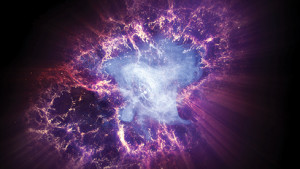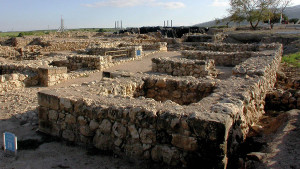As debate over climate change brews, teams of scientists are working to recreate a history of our earth’s climate. But does the history they are finding disprove the biblical account of earth’s history?
A key tool in this quest is the history frozen within the ice sheets that cover Greenland and Antarctica. By using a hollow drill scientists are able to drill down and extract long, thin cylinders of ice, called “ice cores”.1 The cores are made up of layers of ice, appearing something like a translucent tube of Life Savers. Scientists observe that the top layers are formed by annual snowfall. If ancient layers of ice were similarly formed by annual snowfalls and if the chemical composition, levels of pollutants and concentrations of pollens and dust within each layer were a result of the climate at that time, ice cores provide key data to recreating the earth’s climate history over a large expanse of time.
One ice core illustrates the process. On July 1, 1993 a team of scientists finished drilling and extracting the GISP2 ice core near the centre of Greenland. The entire ice core is 3km long and weighs about 40 tonnes. But how many years does it represent, what does it say about our climate history and what does that history say about the veracity of the biblical account of creation?
It’s not always easy to count the number of layers in an ice core precisely. Scientists use different measurement techniques to compare the results, but these measurements don’t always fully agree and some of the measurement techniques can’t be used further down the core.2 Also, layers become very thin deeper in the ice—to the point where scientists can’t visually distinguish any layers at all so they employ an indirect way of counting the layers.3 After checking and adjusting their results, as well as having some friendly arguments along the way, the team of scientists finally arrived at the conclusion that the GISP2 ice core had about 110,000 layers. The scientists then made a critical decision on how to interpret the layers—they assumed all the layers represented individual years. Thus the scientists interpreted their counting of layers in the GISP2 ice core to represent 110,000 years.
Some have pointed to the ice core dating as evidence that the biblical record is inaccurate. Careful analysis of these scientific studies, however, reveals the apparent challenge is not as conclusive as it is often claimed to be. This is for three reasons.
Firstly, the work of counting the layers is not a straightforward, precise process. It's more of an art than a science, and that art is strongly impacted by the assumptions and scientific models of those doing the counting.
Secondly, scientists make the assumption that each single layer represents one year in the history of the ice core. Consequently, the scientific conclusion that the GISP2 ice core represents 110,000 years of climate history, for example, hinges on whether this assumption is true.4 The scientists themselves acknowledge that it's possible for weather conditions like storms to produce multiple layers of ice in any one particular year.5 These layers are usually thinner and closely packed together, like the layers that are found at the bottom of the ice core.6 The impact of forming ice during periods when the earth’s weather varied substantially is not possible to calculate without an independent, detailed record of that variability. This means that the current scientific estimate for the age of the ice core potentially varies dramatically from its actual age.
Third, there is another explanation for layers in the ice cores. The global Flood recorded in Genesis caused extreme and wildly erratic weather conditions. It likely would have been followed by an Ice Age when the massive ice sheets were formed in Greenland and Antarctica.7 In a short period of time this post-Flood Ice Age would have caused large amounts of snowfall and many layers of ice to be formed through the storms that occurred during this time. This would mean that the series of layers in the ice core could be formed in only a few thousand years.8
We have two explanations for the age of the ice cores. The really important question is: which one of them provides the closest estimate for the true age of the cores? The reality is that scientists do not know for certain that their interpretation of the data collected from the ice cores is accurate. As Professor Richard Alley states, “All scientific ideas are subject to revision; we should never be absolutely sure that the truth has been reached.”9 The reason for this is because scientific conclusions are based on unverifiable assumptions, reductionist models and equivocal data. To paraphrase a wise person, there are assumptions that seem right to a modern scientist but they lead to false conclusions.10
So where can we find the truth regarding the history of the earth? We must examine multiple sources of data. One source is ice cores but we can only verify scientific interpretations of the ice core evidence if we have historical records that we can reconcile these interpretations with. Do we have such a historical record that has proven itself to be accurate? The historic source for ancient history that has been demonstrated to be accurate is, of course, the Bible. Despite significant efforts to discredit it, the validity of the historical accounts in the Bible has proven to be reliable time and time again. And part of that account is the Flood record, key elements of which have been corroborated in the written and oral traditions of multiple cultures around the globe, such as characters in the Chinese language. Scientific interpretations of ice core data that have not been reconciled with the implications of such a global flood on weather patterns and ice formations are potentially wildly off the mark.
Ice cores are a fascinating area of study. The data extracted—particularly of relatively recent periods when we have collaborating historic evidence to verify weather conditions and exceptional weather events—is valuable in studying recent climate variations. The science around ice cores becomes much more speculative, however, when we extrapolate data into periods during which far less is known about the earth’s condition and when we exclude from our analysis data from the biblical record.
- For more information on ice cores refer to the introduction on the National Ice Core Laboratory webpage: http://www.icecores.org/icecores/ or the highly readable book by Professor Richard Alley titledThe Two-Mile Time Machine: Ice Cores, Abrupt Climate Change, and Our Future, Princeton University Press: 2002.
- The scientific process of comparing different parameters to date the GISP2 ice core is described in the paper Meese, D. et al. “The Greenland Ice Sheet Project 2 Depth-age Scale: Methods and Results” Journal of Geophysical Research, 102 (C12) 26,411-26,423 (1997). Available at:http://onlinelibrary.wiley.com/doi/10.1029/97JC00269/pdf. Historical records of volcanic eruptions were used to reconcile the dating of the ice core but these records only go back 2000 years. Beyond this point, it is also important to note that even if all of the parameters totally agreed, this does not mean that the scientific estimates of the number of layers are accurate. Professor Richard Alley has noted “Agreement [between these parameters] does not prove accuracy, however; perhaps all of us were being fooled in the same way.” Alley, R. The Two-Mile Time Machine, p 57. He is referring to the reality that we could all be fooled by the scientific assumptions and models being used to interpret the data.
- This measurement technique is called laser-light scattering from dust (LLS). However, it is important to note the following comments about the LLS method: “LLS was a very valuable dating tool throughout almost the entire length of the core, particularly in the deeper ice at GISP2, where the other techniques either fail or become increasingly unreliable. However, an increased particular concentration may not be restricted to the spring or summer and additional influxes of dust may occur during any part of the year, creating additional peaks of a nonannual nature.” Meese, D. et al. “The Greenland Ice Sheet Project 2 Depth-age Scale: Methods and Results”, Journal of Geophysical Research, 102 (C12) 26,411-26,423 (1997).
- The fundamental issue with this assumption is known as the problem of induction. The problem can be illustrated with the following logic: “All swans we have seen are white, and therefore all swans are white.” Anyone from Australia knows that this reasoning is prematurely reductionistic! In the same way, while layers of ice at the top of an ice core can correspond to individual years, it does not follow that all of the layers represent individual years. The problem of induction calls into question all scientific claims based on finite evidence sets.
- As Professor Richard Alley has noted: “Fundamentally, in counting any annual marker, we must ask whether it is absolutely unequivocal, or whether nonannual events could mimic or obscure a year. For the visible strata (and, we believe, for any other annual indicator at accumulation rates representative of central Greenland), it is almost certain that variability exists at the subseasonal or storm level, at the annual level, and for various longer periodicities (two-year, sunspot,etc.). We certainly must entertain the possibility of misidentifying the deposit of a large storm or a snow dune as an entire year or missing a weak indication of a summer and thus picking a two-year interval as 1 year.” R.B. Alley, et al. “Visual-stratigraphic dating of the GISP2 ice core: Basis, reproducibility, and application”, Journal of Geophysical Research, 102 (C12) 26,378, (1997). Available at:http://onlinelibrary.wiley.com/doi/10.1029/96JC03837/pdf.
- “[I]t is possible to have depositional depth-hoar layers form at any time of the year. These typically are thinner and of higher density than the summertime diagenetic depth-hoar layers and so can be distinguished readily in snow pits, but they could complicate observations at greater depths in the core.” R.B. Alley, et al. “Visual-stratigraphic dating of the GISP2 ice core: Basis, reproducibility, and application”, Journal of Geophysical Research, 102 (C12) 26,377-26,378, (1997).
- 7. For a brief introduction into the concept of the post-Flood Ice Age, refer to the Geoscience Research Institute FAQ regarding the Ice Age: http://grisda.org/resources/faq/ice-age/. A more detailed description of the post-Flood Ice Age and an ice core dating model that incorporates the biblical creation and flood accounts is provided in the chapters “The Genesis Flood Caused the Ice Age” and “Do Ice Cores Show Many Tens of Thousands of Years?” in Michael Oard’s book Frozen in Time. Master Books, 2004. Available at: https://answersingenesis.org/answers/books/frozen-in-time/. Note that the GISP2 project team used historical records of volcanic eruptions to reconcile segments of their ice core dating model with the top layers of the ice core, so it is scientifically legitimate for Seventh-day Adventists to use the historical record of the Flood to reconcile the model with the layers in the deeper segments of the core.
- More recently, ice cores from Antarctica have been interpreted to be 420,000 years old (the Vostok ice core) and 740,000 years old (the EPICA Dome C ice core): Petit, J. et al. “Climate and atmospheric history of the past 420,000 years from the Vostok ice core, Antarctica”, Nature 399, 429-439 (1999) Abstract available at: http://www.nature.com/nature/journal/v399/n6735/abs/399429a0.html; Augustin, L. et al. “Eight glacial cycles from an Antartic ice core”, Nature 429, 623-628 (2004). Available at:http://www.nature.com/nature/journal/v429/n6992/full/nature02599.html. These figures have not been produced by counting the number of annual layers, since the annual snow accumulation rate is much lower in Antarctica and so annual layers are not preserved reliably. Instead, major fluctuations or cycles in measurements from the ice cores have been observed and these have been matched with cycles in deep sea sediment cores, which have been interpreted to occur with a periodicity of 100,000 years. The 100,000 year period is based on the astronomical theory known as the Milankovitch theory. Since there were approximately four cycles in the Vostok measurements and eight cycles in the EPICA measurements, the ages of the ice cores were interpreted to be 420,000 years and 740,000 years respectively. However, there are significant problems with the Milankovitch theory. The most relevant problem is that the orbital forcing on the earth’s climate for the 100,000 year period is small, even though this is the dominant periodicity in both the deep sea sediment cores and the ice cores. This is known as the 100,000-year problem. As the English astronomer Fred Hoyle has commented, “If I were to assert that a glacial condition could be induced in a room liberally supplied during winter with charged night-storage heaters simply by taking an ice cube into the room, the proposition would be no more unlikely than the Milankovitch theory.” Hoyle, F. Ice, the Ultimate Human Catastrophe, Continuum, New York, 1981, p 77. This suggests that orbital forcing at the 100,000 year period is not the primary causal mechanism for the cycles in ice core measurements and that other causal mechanisms need to be explored. One viable candidate is rapid post-Flood climate variations, which would mean a much younger age for both the deep sea sediment cores and the Vostok and EPICA ice cores.
- Alley, R. The Two-Mile Time Machine, p 174.
- Proverbs 14:12; 16:25 (ESV). This observation has been confirmed in the inspired counsel that has been given to the Seventh-day Adventist Church in the chapter “The Literal Week”, Patriarchs and Prophets, p 111-116: Available at: http://www.whiteestate.org/books/pp/pp9.html
Dr Sven Ostring is director of Personal Ministries, Sabbath School, Stewardship and Discipleship for the Greater Sydney Conference.






